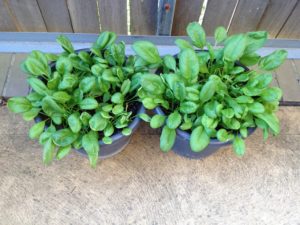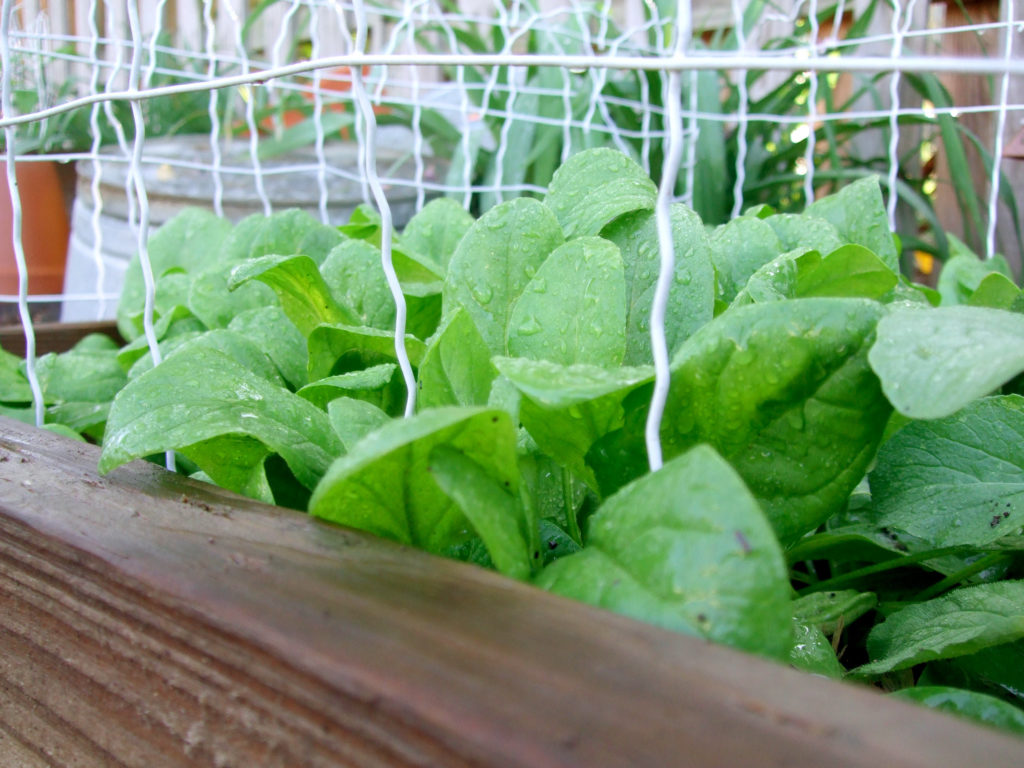Spinach Facts
Spinach is a traditional dark green, leafy vegetable, grown all over the world. It was originally cultivated in ancient Persia, over 2,000 years ago. As a major crop in other regions, it was exported to China first, starting in the 7th Century. It’s still known as “Persian Green” in China. It was introduced in Europe in the 9th Century (starting with Spain), then in northern Europe in the 1300s. March 26th is National Spinach Day! Spinach is used raw as a salad green but is commonly eaten steamed as a delicious side dish. It’s also a common ingredient in soups, stir-fried, or in a multitude of other ways.
There are three main types of spinach cultivated for garden use: Savoy Spinach, Smooth-Leaf Spinach, and Semi-Savoy Spinach. Savoy spinach has curly oval-shaped wrinkly leaves. It usually has a more bitter flavor than the other varieties and is therefore usually cooked rather than being served as a raw dark green, but some do appreciate the flavor! Smooth-leaf spinach has larger, broad, and smooth leaves. It grows a bit more quickly than the savoy varieties, and it can be stored in the fridge for a bit longer after it’s harvested. Semi-savoy spinach is cultivated as a hybrid of savoy and smooth-leaf types. It usually has curly oval-shaped leaves like the savoy spinach but is smooth and not wrinkled. Many semi-savoy types of spinach are disease-resistant. As a hybrid, they should not be cultivated for seeds. All varieties of spinach have similar nutrition, being high in beta carotene, iron, and calcium, and they are all excellent sources of vitamins A, C, and E.
How to Grow Spinach
- Spinach: Spinacia oleracea
- Annual
- Full sun
- Soil should be neutral to slightly alkaline with pH between 6.5 and 8.0
- Rich fertile soil with good compost. Good drainage is necessary, sandy soil is preferred.
- Start seeds 2″ apart, thin to 6” apart
- Garden Rows should be 18″ apart
- Growing in containers:
Start seedlings directly in the pot. One plant in a 6 inch wide, 6-8 inch deep container
Multiple plants can be grown easily in larger containers.
- Water regularly, keeping the soil moist, especially for container-grown spinach.
- Climate Zones 3-10
- Full maturity: 6-8 weeks for leaf harvesting.

You can direct sow seed spinach into your garden. The soil should be fertile, with good drainage. Spinach likes sandy soil but will do OK as long as it’s not solid clay, and has good drainage. For a spring harvest, plant the seeds about three weeks before the last frost of the season. Spinach can also be planted for a fall harvest, six to eight weeks before the first frost of the autumn. Plant one seed about every 2 inches, and once they sprout, watch for the best plants and thin the seedlings to one every 6 inches. Rows of spinach should be planted 18 inches apart. Spinach needs about 1 inch of water each week, to keep the soil moist. Not much additional care is needed. Spinach can also be started indoors, well before the last frost, and transplanted to the garden for an earlier harvest. Plant these 6 inches apart, once the soil has gotten to at least 40 °F.
Spinach is a cool-weather crop. It is fairly cold tolerant and will do pretty well even through a few light frosts. It is heat sensitive however and will bolt once temperatures get over 75 °F or so. The ideal range of temperature is usually between 40 °F and 70 °F for spinach leaves.
Growing Spinach in Containers
Growing spinach in a container is a great option if you have limited garden space, and has a few advantages. Smaller varieties are easier to grow in a container than larger ones. For a single plant, the pot should be at least 6 inches wide and preferably 8-10” deep. With larger containers, as long as there are about 6 inches between each plant, multiple seedlings will do well. A good fertile soil potting mixture is the best option, and be prepared to fertilize it as it grows. Using a nitrogen-rich fertilizer, spinach needs this kind of nutrition. Ensure that the pot drains well, and water several times a week, ensuring to keep the soil moist.
Spinach Pests and Diseases
Pay close attention as your spinach grows in the garden, and take note of any spotting or yellowing in your plants. White rust and downy mildew are two frequently seen diseases that affect spinach. Wet leaves can cause this problem. Using a hose or drip sprinkler at ground level is the best way to protect against disease. Rotating your crops will also help keep recurring diseases in check. Hortisketch is a great way to track year to year what vegetable was planted where! Try to keep the ground moist but the leaves dry, mulch will help with this a lot. Common pests for spinach include aphids, flea beetles, and spider mites. One thing to remember is to water enough but not too much. Overwatering will encourage disease, but overly dry conditions attract spider mites.

Companion planting is another way to keep your spinach free of pests. Garlic, chives, and dill will repel spider mites and aphids, while sage and basil will repel flea beetles. Planting these close by your spinach will not interfere with nutrition and may help keep some of these pests away. Marigold flowers will attract ladybugs and other beneficial insects. This will greatly help with pests as well. Onions, radishes, cabbages, lettuce, beans, and peas are also good companions for garden spinach.
Harvesting Spinach
Spinach leaves can be harvested individually. Do this by carefully removing the larger outer leaves as the plant grows, using them right away. Keep harvesting the outer layer of leaves as it grows. For spring season spinach, harvesting leaves will delay bolting for a little while. Keep harvesting until the weather warms up to the mid 70’s °F, then pull up the entire plant, since it will eventually bolt. For fall season spinach, harvest the individual leaves until the plant reaches full maturity at about 6-8 weeks from sprouting, then pull up the entire plant.

Spinach seed harvesting is different. Use a spring-planted heirloom crop for seeds. Allow some plants to bolt and continue to grow. It’s fine to harvest leaves from these when they are younger, just like with the plants you will pull at full maturity, but the leaves will be bitter after it bolts. Seeds grow close to the main stalk, where the leaves branch off. The seeds will continue to grow. At about 16+ weeks, often in mid-summer, the spinach will have turned yellow-brown, and lay over on the grown, with wilted leaves. Prune off and save the browned and dried stems. These stalks will have seeds that are fully mature. Allow the seeds, still on the stem, to continue to dry in an open container for a few weeks. Once fully dry, break up the seed clusters and separate the seeds from the remaining bits of leaves and stem. Store the seeds until needed for a late summer or early fall planting, or until the following year for a spring planting and harvest. As Popeye would say, Spinach really is strong to the finich!
One more thing-fine sandy particles will cling to the leaves which makes for gritty eating. When I grow spinach, I use plastic sheets to keep the soil off the leaves but you could try newspaper too.

Contact Author
 info@gardensavvy.com
info@gardensavvy.com Recent Posts
- Smart Gardening: How Technology Is Revolutionizing Horticulture
- Understanding Gardening Zones: What You Need to Know
- The Right Tools For Your Gardening And Landscaping Needs
- Maximizing Your Harvest: Square Foot Gardening Chart for Beginners
- Holiday Garden Scents: Plants for Natural Aromatherapy in Your Home









